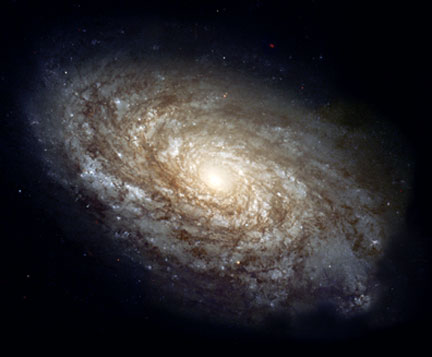
|
The spirals of this galaxy are partly defined by dirty brownish streaks that are distinct in color from the black of space. These brown streaks are vast molecular clouds of cold interstellar gasses and dust that are blocking the light from the stars behind them. This image clearly illustrates that there is a lot of gas and dust out there, but also that it is hard to see this stuff unless we have really high-resolution images and good lighting conditions. While you can see a few points of light representing individual stars (some are between us and the galaxy), at this distance the stars are so tiny as to blur together to give the galaxy its diffuse, cotton candy appearance. It is impossible (at least for me) to imagine so many individual stars! How many of these stars have planets in orbit around them? Side note: The inner stars are slightly yellower and redder than the more bluish outer stars. In general, young stars are smaller, hotter, and consequently give off a bluer light. Near the end of their lives, stars expand to create red giants, which have cooler outer surfaces and give off redder light. Therefore, there are more older colder stars near the center of the galaxy and more younger hotter stars around the outer edges. This tells us something about how galaxies develop over their billions of years of history. Next Image!Image credit: Hubble Space Telescope; The main source for HST images and explanations is HubbleSite.org. |
|
|
|
